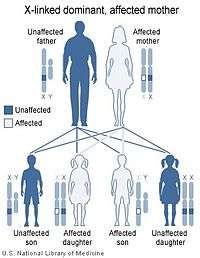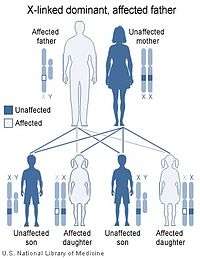Oculofaciocardiodental syndrome
Oculofaciocardiodental syndrome is a rare X-linked dominant genetic disorder.[1]
| Oculofaciocardiodental syndrome | |
|---|---|
  | |
| X-linked dominant inheritance works differently depending upon whether the mother (left image) or father (right image) is the carrier of a gene that causes a disease or disorder. | |
| Specialty | Medical genetics |
Presentation
The incidence of this condition is less than 1 per million. It is primarily only found in females. Its highly rare in males, but some males were born with it. Teeth with large roots (radiculomegaly), heart defects and small eyes (microphthalmia) are the characteristic triad found in this syndrome.
Typical features of the condition include:
- Face
- Deep set eyes
- Broad nasal tip divided by a cleft
- Eyes
- Microphthalmia (small eyes)
- Early cataracts
- Glaucoma
- Teeth
- Radiculomegaly (teeth with very large roots)
- Delayed loss of primary teeth
- Missing (oligodontia) or abnormally small teeth
- Misaligned teeth
- Defective tooth enamel
- Heart defects
- Atrial and/or ventricular defects
- Mitral valve prolapse
- Mild mental retardation and conductive or sensorineural hearing loss may occur.
Genetics
This condition is caused by lesions in the BCOR gene located on the short arm of the X chromosome (Xp11.4). This protein encodes the BCL6 corepressor, but little is currently known about its function. The inheritance is X-linked dominant.
A genetically related disorder is Lenz microphthalmia syndrome.[2]
Diagnosis
Treatment
History
The first features of this syndrome noted were the abnormal teeth, which were described by Hayward in 1980.[3]
References
- Surapornsawasd T, Ogawa T, Tsuji M, Moriyama K (June 2014). "Oculofaciocardiodental syndrome: novel BCOR mutations and expression in dental cells". J. Hum. Genet. 59 (6): 314–20. doi:10.1038/jhg.2014.24. PMID 24694763.
- Esmailpour T, Riazifar H, Liu L, Donkervoort S, Huang VH, Madaan S, et al. (March 2014). "A splice donor mutation in NAA10 results in the dysregulation of the retinoic acid signalling pathway and causes Lenz microphthalmia syndrome". J. Med. Genet. 51 (3): 185–96. doi:10.1136/jmedgenet-2013-101660. PMC 4278941. PMID 24431331.
- Hayward JR (June 1980). "Cuspid gigantism". Oral Surg. Oral Med. Oral Pathol. 49 (6): 500–1. PMID 6930070.